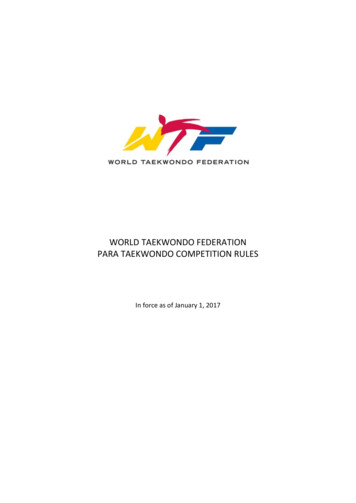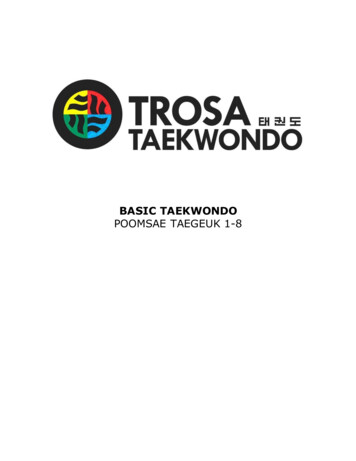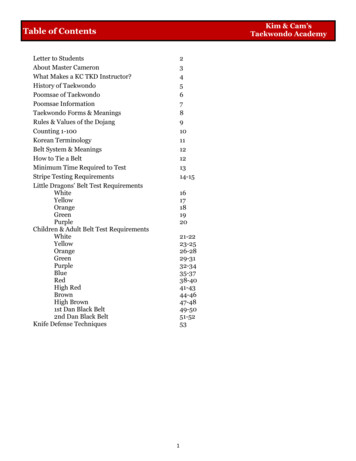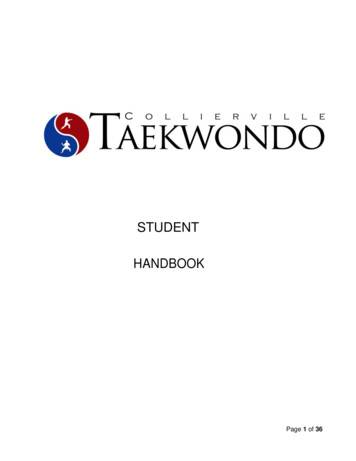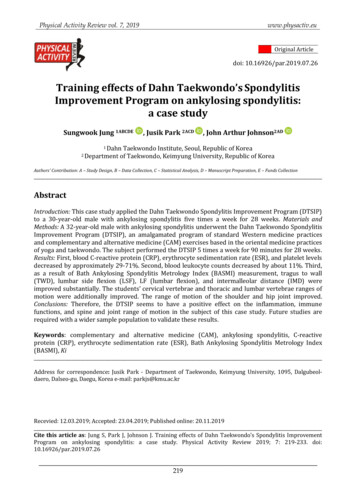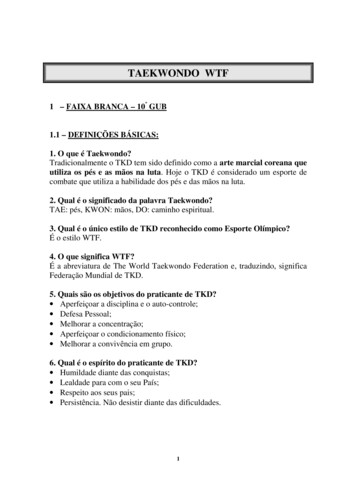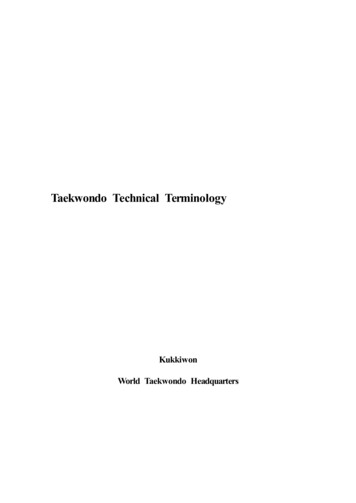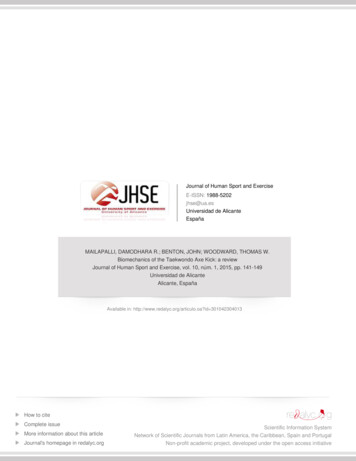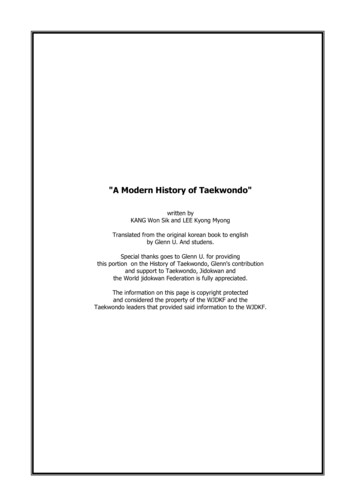
Transcription
"A Modern History of Taekwondo"written byKANG Won Sik and LEE Kyong MyongTranslated from the original korean book to englishby Glenn U. And studens.Special thanks goes to Glenn U. for providingthis portion on the History of Taekwondo, Glenn's contributionand support to Taekwondo, Jidokwan andthe World jidokwan Federation is fully appreciated.The information on this page is copyright protectedand considered the property of the WJDKF and theTaekwondo leaders that provided said information to the WJDKF.
INDEXChapter 1:Chapter 1, SectionChapter 1, SectionChapter 1, SectionChapter 1, SectionChapter 1, SectionChapter 1, SectionChapter 1, SectionChapter 1, SectionChapter 1, Section1:2:3:4:5:6:7:8:9:Chapter 2:Chapter 2, Section 1:Chapter 2, Section 2:Chapter 2, Section 3:unification effortsChapter 2, Section 4:Chapter 2, Section 5:Chapter 2, Section 6:Chapter 2, Section 7:Chapter 2, Section 8:Chapter 2; Section 9:Chapter 2; Section 10:The Development of the KwansChung Do KwanChoson Yun Moo Kwan Kong Soo Do Bu (Jidokwan)Moo Duk KwanYMCA Kwon Bup Bu (Chang Moo Kwan)Song Moo KwanOh Do KwanKang Duk WonHan Moo KwanJung Do KwanThe process of Association unification is full of ups and downsIndependence of August 15, 1961 and the process of Association unificationThe Korean War and the Korea Kong Soo Do AssociationThe newly established Annex Kwans holding their own and the subsequentChoi Hong Hi and the 1959 Korea Taekwondo AssociationHwang Kee and the Korea Soo Bahk Do AssociationThe 1961 Unification Conferences and the different perspectives of the Kwan leadersThe Korea Taesoodo Association: The Entity of UnificationThe Unification of the Dan Promotion Test and Hyung (Forms)The Founding of the Korea Taekwondo AssociationTrouble between the First and Second Generations in TaekwondoChapter 3:The Emergence of Kukki TaekwondoChapter 3; Section 1: 5th President KIM Yong Chae: Developing TaekwondoChapter 3; Section 2: 6th President KIM Un Yong: Rehabilitating TaekwondoChapter 3, Section 3: A Leap in Kukki TaekwondoChapter 3, Section 4: The Discussion regarding the Elimination of Old TeachingMethods and the Restrictions on Kwan Membership TransferChapter 3, Section 5: This and That in 1971Chapter 4:Chapter 4, SectionChapter 4, SectionChapter 4, SectionChapter 4, SectionChapter 4, Section1:2:3:4:5:Chapter 5:Chapter 5, Section 1:Chapter 5, Section 2:Chapter 5, Section 3:Kukkiwon - The Mother Body of RehabilitationThe Early Steps in Building the Central DojangProducing Elite TaekwondoinThe International Taekwondo AcademyThe Taekwondo MuseumKim Un Yong's Efforts in RetrospectThe Prosess of Kwan UnificationThe Formation of the Driving Committee for Kwan UnificationMoving away from the Deep Rooted Kwan RivalriesThe Aftermath of Kwan Unification
A MODERN HISTORY OF TAEKWONDOThis book shows the modern history of Taekwondo by describing major events and facts and episodes thathave not been known to public in modern Taekwondo society in Korea. It traces the changes and developmentof modern Taekwondo up to now: beginning period when various Kwans were created and flourished; period ofunification of different Kwans to Taekwondo; period of development of Taekwondo as a national martial art ofKorea; globalization of Taekwondo; and inclusion of Taekwondo in Sydney Olympic Games as an official sport &continued effort to make Taekwondo as a mandate program of the future Olympics.The book also mentions the meaning and outlines of Poomsae and how Poomsae has become a competition,following Kyorugi. On the other hand, it provides the history of documentary records on Taekwondo over thepast 50 years and history of organizations which have been set up for researches on Taekwondo.Mr. Kang worked for the Korea Taekwondo Association, Asian Taekwondo Union and Kukkiwon. Presently, he isa professor of the Department of Taekwondo at Yong-In University and president of Taekwondo Shinmun, aKorean Taekwondo newspaper.Mr. Lee worked at the World Taekwondo Federation after propagating Taekwondo in Europe for over 20 years.He is a professor of the Department of Sports Diplomacy at Choongcheong College and has published manybooks on Taekwondo.Published in March 1999 by:Bokyung Moonhwasa at 389-22 Seokyo-dong,Mapo-ku, Seoul, Korea 121-210.tel no. 82 2 325 8833/325 7211fax no. 82 2 325 7213.ISBN 89-358-0124-0.8,000 won in Korean currency per copy.
Chapter 1, Section 1: Chung Do KwanRight after the independence of Korea, the Chung Do Kwan, one of the five key Dojangs, was founded first. Itsymbolized Chung Do Kwan's name, Bluewaves, meaning a youngster's spirit and vitality.Chung Do Kwan's founder, LEE Won Kuk, moved to Japan when he was 19 years old in 1926. While in Japan,he first attended middle and high school, and then entered the law school of Chuo University. Then he enteredJapan's Karate headquarters, the Song Do Kwan (Shotokan). He received Karate instruction from Karate'sfather, Funakoshi Sensei. There, he learned Karate with Song Moo Kwan's founder, RO Byung Jick.He moved back to Japan and taught Tang Soo Do in the Yong Shin school hall in Suh Dae Moon Gu's OchunDong, Seoul because he had a good relationship with Japan's Chosun Governor General Abe in 1944. This ledto the rumor that he was pro-Japanese.Later, Oh Do Kwan's founder, CHOI Hong Hi said "After independence, LEE Kwan Jang was charged with actsof pro-Japanese and stood in a special civil trial."LEE Won Kuk was a precise person. He had a strong body of a martial artist and glaringly sharp eyes. Hisexpression was very strict. Right after the independence day, he seemed to offset his pro-Japanese deeds bydeveloping a good relationship with people of the National Police Headquarters. He led the efforts to get rid ofSeoul gangsters. The Chung Do Kwan was once called the National Police Headquarters dojang.After the Korean War, the Chung Do Kwan members were less than 200. GM LEE Won Kuk visited the schooltwice and watched the lessons. The primary instructors were YOO Ung Jun and SON Duk Sung, with promotiontests given every six months.Graduates of the Chung Do Kwan were: 1. YOO Ung Jun2. SON Duk Sung3. UHM Woon Kyu4. HYUN Jong Myun5. MIN Woon Sik6. HAN In Sook7. JUNG Young Taek8. KANG Suh Chong9. BAEK Joon Ki10. NAM Tae Hi11. KO Jae Chun12. KWAK Kuen Sik13. KIM Suk Kyu14. HAN Cha Kyo15. JO Sung Il16. LEE Sa Man17. RHEE Jhoon Goo (Jhoon Rhee)18. KIM Song SikFrom Inchon, which became the center of the Chung Do Kwan's annex Kwans, more schools were opened.They were:1)2)3)4)KANG Suh Chong's Kuk Mu KwanLEE Yong Woo's Jung Do Kwan in Suh Dae Moon KuKO Jae Chun's Chung Ryong Kwan in Kwang JuCHOI Hong Hi's Oh Do KwanThe Oh Do Kwan especially had active Chung Do Kwan members who were in the military after the KoreanWar.The Chung Do Kwan's first Kwan Jang was LEE Won Kuk; the second was SON Duk Sung; and the third wasUHM Woon Kyu. When SON Duk Sung because the Kwan Jang of the Chung Do Kwan, UHM Woon Kyu, HYUNJong Myun, and NAM Tae Hi had conflicts with regard to the issue of who should receive the nomination fromLEE Won Kuk and become the next Kwan Jang.
Chapter 1, Section 2: Choson Yun Moo Kwan Kong Soo Do Bu (Jidokwan)The Jidokwan was founded by an elite member, CHUN Sang Sup, on May 3, 1946 as the Choson Yun MooKwan Kong Soo Do Bu.When he was a teenager, he learned Judo and learned Karate while studying abroad in Japan. After theIndependence Day, he opened the Choson Yun Moo Kwan Kong Soo Do Bu at the former Judo school, ChosonYun Moo Kwan, where he taught Judo and Karate. He began to recruit new members. He had a slender figureand was not particular, but was an intellect and always wore suits. However, during the Korean War, hevanished, the Choson Yun Moo Kwan Kong Soo Do Bu was abolished and it was renamed Jidokwan.After Independence Day, the Choson Yun Moo Kwan taught no guep (mu guep) to 8th guep in high, middleand low classes. The student's Kwan number was based on guep promotion, and not only the day of the firstregistration as a student.The Choson Yun Moo Kwan was started in Seoul, but the major development and structural growth was spreadfrom Chun Ju, Cholla Buk Do as a center. Then, CHUN Il Sup opened another school in Kunsan, Cholla Buk Doin May 1947, and spread his school's reputation from Jun Joo to Kunsan, I Ri, Nam Won, Jung Uep and more.During the Korean War, the Choson Yun Moo Kwan's name was changed to Jidokwan. After CHUN Sang Supwas kidnapped to North Korea, the Jidokwan (Wisdom Way School) was opened and ran by YOON Kwe Byungand LEE Chong Woo until 1967. However, through the process of unification with the Korea Tae Soo DoAssociation, the Jidokwan had conflicts between YOON Kwe Byung and LEE Chong Woo. Led by LEE ChongWoo (Jidokwan), LEE Nam Suk (Chang Moo Kwan), UHM Woon Kyu (Chung Do Kwan), HYUN Jong Myun(Chung Do Kwan/Oh Do Kwan) and others planned to unify, but YOON Kwe Byung and HWANG Kee (Moo DukKwan) declined and persisted on their self testing committee.Jidokwan graduates were:1. BAE Young Ki2. LEE Chong Woo3. KIM Bok Nam;4. PARK Hyun Jung5. LEE Soo Jin6. JUNG Jin Young7. LEE Kyo Yoon8. LEE Byung Ro9. HONG Chang Jin10. PARK Young Kuenand others.Jidokwan's distinguished difference from other schools was mainly based on Kyorugi (sparring). WhenTaekwondo tournaments became active from the beginning of the 1960's to the 1970's, Jidokwan distinguisheditself. The major representatives were LEE Seung Wan, CHO Jum Sun, HWANG Dae Jin, CHOI Young Ryul andmore.Jidokwan's representing annex was the Han Moo Kwan. But, LEE Kyo Yoon said hes Han Moo Kwan root is notJidokwan, but rather the Choson Yun Moo Kwan. This shows the debate of the origins of the school.Jidokwan's first Kwan Jang (grandmaster) was CHUN Sang Sup; the second Kwan Jang was YOON Kwe Byungand the third LEE Chong Woo.
Chapter 1, Section 3: Moo Duk KwanAfter Independence Day, the Moo Duk Kwan started as the "Transportation by Rail Committee Tang Soo DoBu" at the railroad system at Yong San Station, Seoul.The Department of Transportation allowed the Tang Soo Do Dojang as a traffic service, but the exact date isunknown. We only know that it was founded after 1946.HWANG Kee claimed that he learned Kuk Sool when he worked for the Southern Manchuria Railroad in 1935,but other Taekwondo seniors denied this claim saying that there was no evidence.Moo Duk Kwan was nearby the Yong San Railroad station, so it was called the "Railroad Dojang". The first MooDuk Kwan dan holder was KIM Woon Chang.Others were:1. HONG Chong Soo2. CHOI Hui Suk3. YOO Kwa Young4. NAM Sam Hyun5. KIM In Suk6. LEE Bok Sung7. HWANG Jin Tae8. WON Yong Bup9. CHUNG Chang Young10. LEE Kang Ikand others who were all railroad personnel.The Moo Duk Kwan used the trains to open a school in different railroad station's storage rooms and spread itspower. When someone said Moo Duk Kwan, one would think about the railroad.When the Moo Duk Kwan had rank testings, the Chung Do Kwan's LEE Won Kuk and Song Moo Kwan's ROByung Jick visited and built a good friendship, but regarding dan certificates and promotions, they haddisagreements with HWANG Kee.In 1955, the Moo Duk Kwan Central Gymnasium was opened near Seoul Station in Joong Gu's Dong Ja Dong,Seoul. In the same year, 9 more annex schools were opened and it held the friendly China-Korea InternationalTang Soo Do Championships.But in 1960, the Moo Duk Kwan had a big change. The Moo Duk Kwan was no longer 1953's Korea Tang SooDo Association, and it was changed to a Korean traditional name, the Korea Soo Bahk Do Association.Later the Moo Duk Kwan had big headaches because of HWANG Kee's persistence in not unifying with the KTA.Finally, in March 1965, KIM Young Taek and HONG Chong Soo led the Moo Duk Kwan unification with the KTAwithout HWANG Kee.After that incident, LEE Kang Ik became the next Kwan Jang, but soon after resigned with HONG Chong Soobecoming the third Kwan Jang. After, OH Se Joon became Kwan Jang. The Moo Duk Kwan's customs were thestrongest among the first five big Kwans.
Chapter 1, Section 4: YMCA Kwon Bup Bu (Chang Moo Kwan)YOON Byung In, who taught Moo Do with CHUN Sang Sup in the Choson Yun Moo Kwan, founded the ChangMoo Kwan in 1946 at the YMCA in Jong Ro, Seoul. He spent his childhood in Manchuria and learned "Joo AnPa", a Chinese martial art. Right before Independence Day, he went to Japan to study abroad and learnedKarate, receiving the 5th Dan rank. Nihon University's Karate founder TOYAMA Kanken saw YOON Byung In'sChinese martial art and was impressed. Later, they exchanged their martial arts and became good friends.YOON Byung In's passion towards martial arts was so high that he received the 5th Dan in Karate. He was theKarate Team Captain at Nihon University. This showed his martial art ability was high.Right after Independence Day, he became the Physical Education instructor at Kyung Sung Agricultural Schooland started teaching Moo Do. Later, in 1946, YOON opened the YMCA Kwon Bup Bu in nearby Jong Ro, Seoul.He had a good relationship with Choson Yun Moo Kwan's CHUN Sang Sup, and once CHUN and YOON werecalled brothers because they trained so much together. CHUN Sang Sup's younger brother CHUN Il Sup said:"YMCA Kwon Bup Bu's YOON Byung In and LEE Nam Suk trained with the Choson Yun Moo Kwan inthe beginning, so I can say the Yun Moo Kwan and the YMCA Kwon Bup Bu were brother Kwans."YOON Byung In was basically a traditional Moo Do man. His body was small, but was trained with martial artsand full of energy. His behavior was blunt. He did not know how to wear his clothes and shoes fashionably. Hewore a pair of oversized US Army boots and his left baby finger was cut off, so he had to wear a pair of specialwhite gloves, even in the summer.He taught his martial art (Ju An Pa Kwon Bup) to his students according to their body sizes, so the studentscould learn martial arts that suited their body specialty.Before the Korean War, on June 24, 1949, the YMCA Kwon Bup Bu held a Yun Moo Demonstration. PARK ChulHee demonstrated the "Jak Do Kwon", PARK Ki Tae demonstrated "Bong Kwon" and Chung Do Kwan's SONDuk Sung, UHM Woon Kyu and LEE Yong Woo demonstrated Chan Jo.YMCA Kwon Bup Bu practice sessions started at 4:30 pm. In the beginning, more than 500 members wererecruited, but after three months, only 180 members were remaining because of the severity of the training.After YOON disappeared, LEE Nam Suk opened a Kong Soo Do school and started teaching.After the Korean War, LEE Nam Suk and KIM Soon Bae reopened the YMCA Kwon Bup Bu as the Chang MooKwan. The Chang Moo Kwan was represented with a symbol of two dragons. But according to LEE Chong Woo,the Chang Moo Kwan name was used by YOON Byung In as a favorable name before the Korean War.YMCA Kwon Bup Bu graduates were:1. LEE Nam Suk2. KIM Sun Gu3. HONG Jung Pyo4. PARK Chul Hee5. PARK Ki Tae6. KIM Ju Gap7. SONG Suk Joo8. LEE Joo Ho9. KIM Soon Baeand others.2nd Kwan Jang LEE Nam Suk and 3rd Kwan Jang KIM Soon Bae had conflicts with HONG Jung Pyo and PARKChul Hee. This led to HONG and PARK leaving the Chang Moo Kwan and opening their own school, the KangDuk Won, in nearby Shinsuldong, Seoul, in 1956.
Chapter 1, Section 5: Song Moo KwanThe Song Moo Kwan was founded by RO Byung Jick in Kae Song in 1946. Song Moo Kwan founder RO ByungJick studied together with Chung Do Kwan founder LEE Won Kuk in Japan. They both studied Karate underFunakoshi Sensei. Right before the Independence Day, he returned to Korea and taught youngstersKarate as a hobby at an archery place, the Kwan Duk Jung.RO Byung Jick explained his school's name: "Song Moo Kwan's *Song* meant pine tree, which meant greenand a long life. Also, Song was one of the Koryo capital city name, Song Do. And Song was also borrowed fromthe Song Do Kwan (Shotokan) when I learned Karate under Funakoshi while studying abroad."RO's practice sessions started one hour earlier with warm up exercises consisting of lifting weights and thenpracticing on the Kwon Go (makiwara). He was known as a powerful puncher and kicker from his students.RO always let his students punch the Kwon Go at least 100 times and then started the real practice. If studentsreceived the 4th Guep or higher, he let them spar. Like any other dojang, he was known to let his studentspractice in cold weather during winter, and in the hot weather during summer.RO Kwan Jang's student, and the 2nd Kwan Jang, LEE Young Sup reflects: "Every six months, there was testingfor promotion. Mainly one step sparring, three step sparring, free sparring and forms were used to decidepromotions. But free sparring was for 4th guep and higher, and 1st Dan required breaking a board. If theserules were broken, the Kwan Jang was very upset."The Song Moo Kwan graduates were:1. LEE Hwae Soon2. LEE Young Sup3. KIM Hong Bin4. HAN Sang Min5. SONG Tae Hak6. LEE Hwi Jin7. JO Kyu Chang;8. HONG Young Chang9. KANG Won Sik (co-author of this book)and others.However, its power and customs were the weakest among the first big five Kwans.Song Moo Kwan's first Kwan Jang was RO Byung Jick; the second was LEE Young Sup and the third KANG WonSik.
Chapter 1, Section 6: Oh Do KwanThe Oh Do Kwan is a product of former ROK Army members CHOI Hong Hi and NAM Tae Hi. NAM Tae Hi madea big contribution to the Oh Do Kwan, which was founded by CHOI Hong Hi in the 3rd Army Yong Dae Ri base.For CHOI, NAM was a treasure.NAM registered at the Chung Do Kwan right after Independence Day. After he learned Tang Soo Do from LEEWon Kuk, he taught Tang Soo Do at the Military Signal School in 1947. This led to his faith and loyalty with themilitary. A handsome man with excellent administrative skills, NAM's Tang Soo Do was great. After he metGeneral Choi of the 29th Infantry Division in Chejudo, this was the beginning of his changing life.The Oh Do Kwan had new members that were mostly former members of the Chung Do Kwan.They were:1. NAM Tae Hi2. HAN Cha Kyo3. WOO Jong Rim4. KO Jae Chun5. KIM Suk Kyu6. KWAK Kuen Sukand others.Instructors were HYUN Jong Myun and others who were from the Chung Do Kwan. After HYUN Jong Myuntaught for more than 10 years since 1954, he became the Kwan Jang. There is a rumor that this relates toCHOI, who became the Chung Do Kwan's Honorary Kwan Jang.After ROK President RHEE Syng Man sponsored General Choi, the Oh Do Kwan grew rapidly since 1955. Hisplan to teach Tang Soo Do to everyone in the military led to changing Tang Soo Do's name to Taekwondo.When he taught Taekwondo, he instructed his students to yell out "TAE KWON!" When the Vietnam War brokeout in the early 1960's, General Choi sent Taekwondo instructors to Vietnam. This led to the discriminationagainst civilian dojangs and spread his dojang's reputation.Taekwondo instructors were sent to Vietnam in December 1962. NAM Tae Hi was the head of the group, andKIM Seung Kyu, JUNG Young Hwi and CHOO Kyo were the instructors. Until the evacuation of the ROK military,657 instructors were dispatched.Successive generation Taekwondo instructors were:1.2.3.4.5.6.7.8.NAM Tae HiBAEK Joon KiCHOI Dong HeeKIM Suk KyuKO Jae ChunKIM Bong SikJUNG Byung KilKIM Sueng KyuMostly, they were former Chung Do Kwan members. However, when new military recruits who had Taekwondodan rank joined, the Oh Do Kwan only approved Chung Do Kwan dan ranks. The dan ranks from other Kwanswere not approved and they were called "Civilian Dan rank", so the new recruits had to pass another test toreceive Dan rank in the military. This caused complications between the Oh Do Kwan and other Kwans.Regarding this issue, General Choi defended the action and said: "The Oh Do Kwan had frequent exchanges ofbasic forms and similar practice sessions with the Chung Do Kwan, but the Jidokwan, Chang Moo Kwan andother schools had different structural forms. So the military needed to test their members."After CHOI Hong Hi founded the International Taekwon-Do Federation, CHOI deviated from the KTA andweakened the Oh Do Kwan. HYUN Jong Myun was the second Kwan Jang, KWAK Byung Oh (Jak Ko) was thethird, and BAEK Joon Ki was the third Kwan Jang for the Oh Do Kwan.
Chapter 1, Section 7: Kang Duk WonThe Kang Duk Won was founded after the Korean War in 1956 by two people who practiced martial arts at theYMCA Kwon Bup Bu. They were HONG Jong Pyo and PARK Chul Hee. The first Kwan Jang was HONG Jong Pyo.The Kang Duk Won was founded after YMCA Kwon Bup Bu's founder, YOON Byung In, was kidnapped to NorthKorea. HONG Jong Pyo and PARK Chul Hee had conflicts with LEE Nam Suk and KIM Soon Bae, which led to aseparation. Regarding this, Kang Duk Won's second Kwan Jang, PARK Chul Hee, said: "After the Korean War,when the members were scattered, the Chang Moo Kwan and Kang Duk Won came out of the YMCA Kwon BupBu's root. Therefore, we cannot say that the Kang Duk Won was from the Chang Moo Kwan."After starting the dojang in Shin Sul Dong, Seoul in 1956, Kang Duk Won was named, which meant "a house ofteaching generosity". This motto became the symbol of the Kang Duk Won.The Kang Duk Won was not a big school. The first members were:1. LEE Kum Hong (the present WTF Secretary General);2. KIM Yong Chae (5th KTA President)3. LEE, Jung Hoo4. LEE, Kang Hwi5. HAN Jung Il6. KIM Pyung Soo7. JI Seung Won8. IM Bok Jinand others.Later the Kang Duk Won constantly moved from Chang Sin Dong to Chung Jin Dong to Suh Dae Moon Gu toSeoul Gymnasium to Suh Dae Moon Gu Lottery and other places. When LEE Kum Hong became the third KwanJang, the Kang Duk Won moved to In Sa Dong and settled there. Presently, the Kang Duk Won Moo DoHwe (Kang Moo Hwe) continues on.Chapter 1, Section 8: Han Moo KwanLEE Kyo Yoon founded the Han Moo Kwan in August 1956, and it was the leader of the new schools in the mid1950's. Even now, LEE Kyo Yoon denies that the Han Moo Kwan was a split from the Jidokwan. After theChosun Yun Moo Kwan's CHUN Sang Sup was kidnapped to North Korea during the Korean War, everythingwas in chaos, so LEE Chong Woo opened the Jidokwan, and he himself opened the Han Moo Kwan. ThereforeHan Moo Kwan's root is not Jidokwan, but rather from the Chosun Yun Moo Kwan. This is LEE Kyo Yoon'sclaim.LEE Kyo Yoon says: "In November 1950, I came back to Seoul and taught Tang Soo Do (Taekwondo). But theChoson Yun Moo Kwan's LEE Jae Hwang said the building I was using was a Yudo place, so he insisted that Ileave. After thinking for a long time, I went to visit Vice President LEE Sang Mook of the Korean Amateur SportsGymnasium (Han Kuk Che Yuk Kwan, Han Che for short) and he allowed me to start a Taekwondo club andteach."Back then, the Han Kuk Che Yuk Kwan taught boxing, Judo, wrestling, weight lifting and fencing as a universalgym. With the permission of LEE Sang Mook, LEE Kyo Yoon taught Taekwondo (Tang Soo Do) temporarily andsecured 200 members. However, conflicts with LEE Chong Woo became amplified and with LEE Sang Mook'ssuggestion, he temporarily stopped teaching Taekwondo. Then he went to Chang Sin Dong of Jong Ro Gu,Seoul at the backyard of Kang Moon High School to open his own school. This led to the founding of the HanMoo Kwan. The period of the Chang Sin Dong was a hardship. He called his tent with a straw mat for a floor, adojang. Despite this hard life, his school reputation grew and finally in 1969, he could open his central dojangin Wang Sip Ni, Seoul.
Chapter 1, Section 9: Jung Do KwanThe Jung Do Kwan was founded by LEE Yong Woo (presently a Kukkiwon Promotion Test Committee member)right after the Korean War in 1954 at the Lottery in Suh Dae Moon Gu, Seoul. The Jung Do Kwan had noconflicts or disagreements with the Chung Do Kwan, which was a unique difference from the other Chung DoKwan branch or annex Kwans.LEE Yong Woo discusses the naming of his school: "I wanted to open a dojang, but just couldn't think of anygood names. At that time, my training buddy, UHM Woon Kyu in the Chung Do Kwan suggested to take out thedot from Chung character and name my school the Jung Do Kwan. This was a very good idea I thought. Themeaning of Jung Do, 'Stepping the right way', was the identical meaning of a martial artist's spirit, so I'vedecided to name my school the Jung Do Kwan."Back then the Jung Do Kwan's area was about 100 pyong. However, word of LEE Yong Woo's unique trainingprogram that was distinctive from other schools attracted many students. To meet the increasing number ofstudents, LEE Yong Woo taught five different classes, which finished late at night.With the school's motto, "I am an honorable man without shame", the Jung Do Kwan opened additional schoolsin Masan, Wool San, Chang Won, Mok Po and Kim Je, spreading its power.The Jung Do Kwan's first students were:1.2.3.4.5.6.JANG Yong GapKIM Jae KiKIM Ki DongOH Bu WoongJOO Ki MoonPARK Tae HyunLater, following in their footsteps were:1.2.3.4.5.6.7.PARK Kyung SunSHIM Myung GuKIM Myung HwanKIM Hak KuenCHUN Young KuenCHUN Sun YongLEE Jong OhChapter 2:The process of Association unification is full of ups and downsFollowing Independence Day and the Korean War, social disruptions swept through the Korean peninsula whichled the five major Kwans and the Taekwondo pioneers to feel the need for a unified Association. The leadersand pioneers wanted to distinguish Korea's own martial arts from other foreign arts and re-establish thetraditional Korean fighting skills.Unifying and developing Taekwondo into a National Sport became the agreed objective for the Taekwondoleaders and pioneers. Therefore, since the 1950's, the Korea Taekwondo Association went through Dae HanKong Soo Do, Dae Han Tae Soo Do and finally became a unified Taekwondo community.This process is called the "Disorder Period". Because of the Kwans and Kwan Leader's relationships andmisunderstandings with each other, the process had to suffer from numerous misapprehension. Especially,HWANG Kee's protrusion out of the unified association was a big obstacle to the process.Between the mid 1950's and 1960's, when the movement of Association unification began, more Annex Kwans(sub-kwans) came into existence, such as the Oh Do Kwan, Kang Duk Won, Jung Do Kwan, Han Moo Kwan,Kuk Mu Kwan, Yun Moo Kwan, Soo Moo Kwan, Chang Hun Kwan, Moon Moo Kwan and others. There wereabout 40 newly derived Annex Kwans which led the age of Taekwondo. When CHOI Hong Hi used his militaryauthority to hop into the Taekwondo world by founding the Oh Do Kwan, the civilian Kwan leaders andpioneers and he began to develop complications regarding the direction of Taekwondo.
Chapter 2, Section 1: Independence of August 15, 1961 and the process of Association unificationMost of the masters thought all the traditional and various martial arts schools should be united during theJapan occupation. Following the liberation of Korea on August 15, 1945, Taekwondo entered a new phase.Following LEE Won Kuk's founding of the Chung Do Kwan, the Chosun Yun Moo Kwan Kong Soo Do Bu, YMCAKwon Bup Bu, Moo Duk Kwan and Kae Song's Song Moo Kwan (the Five Major Kwans) competed anddeveloped Taekwondo with good intentions. At this time, the Kwan founders agreed to organize a unifiedAssociation.Representatives LEE Won Kuk (Chung Do Kwan), CHUN Sang Sup (Chosun Yun Moo Kwan Kong Soo Do Bu),YOON Byung In (YMCA Kwon Bup Bu) and RO Byung Jick (Song Moo Kwan) had several meetings toaccomplish their objective. Despite their eagerness and agreement, there were misunderstandings andobstacles that could not be overcome.After the attempted Association failed, each Kwan concentrated on training its younger generation.Unexpectedly, the Korean War broke out and the land of Korea was under war's calamity and flame. TheTaekwondo community was no exception and many leaders were separated from their Kwans and scatterednorth and south. This was a period of chaos and disorder.Chapter 2, Section 2: The Korean War and the Korea Kong Soo Do AssociationDuring the Korean War, the Taekwondo men who were refugees in the temporary capital city of Pusan, agreedto organize an Association and finally decided to found the Korea Kong Soo Do Association. The organizingmembers were RO Byung Jick, YOON Kwe Byung, SON Duk Sung, LEE Nam Suk, LEE Chong Woo, HYUN JongMyun, JO Young Joo, and KIM In Hwa.To build public confidence, the Korea Kong Soo Do Association included non-Taekwondo men in the committee,but the key players were the Taekwondo practitioners. The first President, JO Young Joo, was head of theAssociation of Korean Residents in Japan.However, less than one month after the founding of the new Association, Moo Duk Kwan President HWANG Keewithdrew from the Association because he was not given a position on the Central Testing Committee. Afterone month following HWANG Kee's withdrawal, Chung Do Kwan President SON Duk Sung withdrew for thesame reason. Therefore, the attempt for the complete unification of all the Kwans was another failure.After HWANG Kee returned to Seoul, he personally organized the Korea Tang Soo Do Association and waseager to join the Korea Amateur Sports Association. After YOON Kwe Byung and RO Byung Jick realized theseriousness of the situation, they submitted a petition to stop the Korea Tang Soo Do Association from joiningthe Korea Amateur Sports Association. This impediment was successful.The new President of the Korea Kong Soo Do Association was LEE, Joong Jae, who was the ROK Minister ofFinance, with MIN Kwan Sik's recommendation. The Chief Director was RO Byung Jick and the SecretaryGeneral was LEE Chong Woo.The role of the Korea Kong Soo Do Association was to test and qualify promotions and issue official recognitionof Dan rank. To unify all the Dan ranks, the seniors were promoted to 4th Dan.The first and second Promotion Tests of official recognition were held in the temporary Central Dojang of theChung Do Kwan, which used the Si Chun Church (Hope Wedding Hall) as a gym in the evenings. The third andfourth Promotion Tests were held at the Chae Shin Bu Dojang (next to the old Capitol Building) which was runby LEE Nam Suk. RO Byung Jick and YOON Kwe Byung took fu
past 50 years and history of organizations which have been set up for researches on Taekwondo. Mr. Kang worked for the Korea Taekwondo Association, Asian Taekwondo Union and Kukkiwon. Presently, he is a professor of the Department of Taekwondo at Yong-In University and president of Taekwondo Shinmun, a Korean Taekwondo newspaper.
